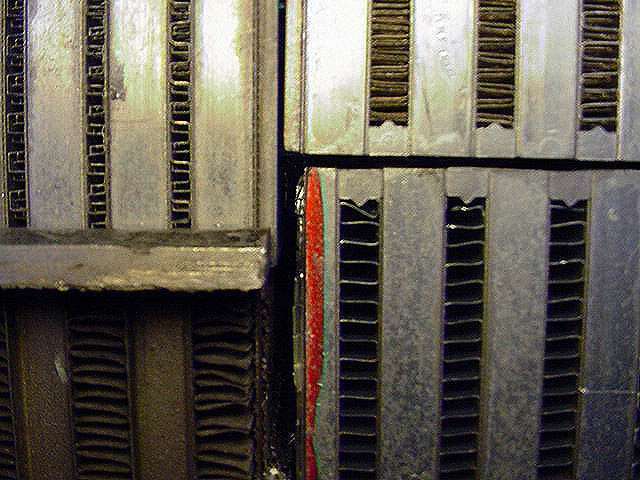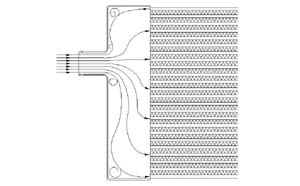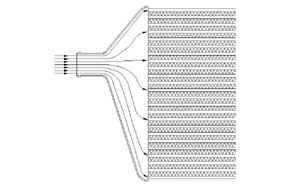That's actually a tough question because there is a lot of stuff acting behind the scenes. To (over)simplify, here are some very general rules on ICs:
Longer Intercoolers:
Cool better*
Have more pressure drop
Taller ICs:
Cool better*
Have less pressure drop
Thicker ICs:
Cool slightly better
Have less pressure drop
*Assuming that all of the IC face is still exposed to fresh air
So I'm not even sure if "Volume" is that useful of a reference. To go into a little more detail (on Cores alone), here is some data from Bell:

IC #1:
3x12x12
Frontal area: 144
Volume: 432
CFM: 619
IC #2:
3x6x24
Frontal area: 144
Volume: 432
CFM: 237
IC #3:
3x24x6
Frontal area: 144
Volume: 432
CFM: 1385
I've simplified it so all 3 intercoolers have the same frontal area and volume , but you can see that the taller/shorter the IC, the better it flows.
Not lets take IC #2 and play with lengths:
IC #2:
3x6x24
Frontal area: 144
Volume: 432
CFM: 237
IC #4:
3x6x12
Frontal area: 72
Volume: 216
CFM: 302
IC #5:
3x6x6
Frontal area: 36
Volume: 108
CFM: 350
This should make sense -- the longer the intercooler, the more restriction -- which means the lower the CFM at a given pressure drop. IC #2 will cool best out of this group, IC 5 will flow best...
Now lets take IC #1 and play with thickness:
IC #1:
3x12x12
Frontal area: 144
Volume: 432
CFM: 619
IC #6:
4.5x12x12
Frontal area: 144
Volume: 648
CFM: 928
IC #7:
6x12x12
Frontal area: 144
Volume: 864
CFM: 1238
IC #7 won't cool twice as much as IC #1, but it will still cool a little better. And it flows twice as much.
OK, so the above should make flow rates fairly clear -- but it's still lacking some details on heat transfer:
Newton's Law of Cooling:

Q = Thermal energy in joules
h = Heat transfer coefficient
A = Surface area of the heat being transferred
T = Temperature of the object's surface and interior (since these are the same in this approximation)
Tenv = Temperature of the environment
ΔT(t) = T(t) − Tenv is the time-dependent thermal gradient between environment and object
Before your eyes glass over, it isn't that bad. For our Air-to-Air ICs, all we need to see is:
The more surface area -- the more heat transferred
The greater the temperature difference -- the more heat transferred
Pretty simple, right? So let's see how it applies to the various core dimensions:
Longer Intercoolers:
* Increase total surface area (more heat transferred)
* Increases the time the charge air spends inside the intercooler (more time for heat to transfer, but less efficiently at the end of the IC than beginning. Remember that the greater the temperature difference, the more heat transfer, and the charge air will cool as it passes through the IC so deltaT is lower near the outlet).
Taller Intercoolers:
* Increase total surface area (more heat transferred)
* No change in time the charge air spends inside (IC efficiency doesn't drop off as much from one side of core to other)
Thicker intercoolers:
* Increase total surface area (remember there are comparably more fins even though frontal area is unchanged). However, the ambient air temperature goes up as it passes through the IC (ambient at entrance of IC, hotter in middle, hottest at exit). So while the total surface area increases, the heat exchanging efficiency decreases the thicker you go since the temperature gradient becomes smaller.
From this we see that the most efficient IC for maximum heat exchange and minimal pressure drop is going to be a short, tall IC (pretty much the opposite of the stock IC). The compromises start when we need to worry about airflow -- does the bumper block airflow to the top of the IC? Will the IC block airflow to the radiator (or heat it up too much)? Ah, now the factory design starts to make more sense...
OK, so why not just go with the biggest sucker that will fit? Larger cores cost more, but more importantly, they also increase lag. Ideally you match the core to your power & cooling needs (someone running race gas on the road course in Canada will want a smaller IC than someone trying to get the same power from pump gas in Texas for highway racing).
Still with me? "But wait, there's more..." All of this assumes that each shop is using comparable cores & end tank designs (they're not!).

Close-up Garret (top) vs Spearco (bottom):

Squared end tanks increase turbulence (and increase the pressure drop)

Rounded end tanks decrease turbulence (and decrease pressure drop)

more info:
http://www.are.com.au/feat/techtalk/intecoolersMR.htm
http://dvdtfab.com/intercoolertestlab.pdf